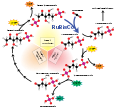Calvin cycle
Calvin Cycle
The Calvin cycle is a set of light-independent chemical reactions that occur in photosynthesis in the chloroplasts of plant cells. Named after Melvin Calvin, who won a Nobel Prize in Chemistry for his work on the cycle, it is also known as the Calvin-Benson cycle or the light-independent reactions.
Overview[edit]
The Calvin cycle takes place in the stroma of the chloroplasts, where it uses the energy stored in ATP and NADPH during the light-dependent reactions to convert carbon dioxide into glucose. This process is crucial for life on Earth, as it is the primary route by which carbon dioxide is converted into organic compounds.
Stages of the Calvin Cycle[edit]
The Calvin cycle can be divided into three stages: carbon fixation, reduction, and regeneration of the starting molecule.
Carbon Fixation[edit]
In the first stage, a molecule of carbon dioxide is combined with a five-carbon sugar called ribulose bisphosphate (RuBP) by the enzyme RuBisCO. This reaction produces a six-carbon compound that immediately splits into two three-carbon compounds.
Reduction[edit]
In the second stage, the three-carbon compounds are reduced to glyceraldehyde 3-phosphate (G3P) using the energy from ATP and NADPH. Some of the G3P is used to produce glucose, while the rest is used in the next stage of the cycle.
Regeneration[edit]
In the final stage, the remaining G3P is used to regenerate RuBP, allowing the cycle to continue.
Significance[edit]
The Calvin cycle is a fundamental process in the global carbon cycle, as it allows plants to convert carbon dioxide into organic compounds. This not only provides the energy that plants need to grow, but also forms the basis of the food chain for all other organisms.

This article is a biochemistry stub. You can help WikiMD by expanding it!

This article is a photosynthesis stub. You can help WikiMD by expanding it!
-
Structure of a chloroplast
-
Overview of the Calvin cycle
-
Calvin cycle step 1
-
Calvin cycle step 2 (doubled)
-
Calvin cycle step 3
-
Phase of regeneration in the Calvin cycle
-
Calvin cycle
-
Overall process of the Calvin cycle
Ad. Transform your life with W8MD's Budget GLP-1 injections from $75


W8MD offers a medical weight loss program to lose weight in Philadelphia. Our physician-supervised medical weight loss provides:
- Weight loss injections in NYC (generic and brand names):
- Zepbound / Mounjaro, Wegovy / Ozempic, Saxenda
- Most insurances accepted or discounted self-pay rates. We will obtain insurance prior authorizations if needed.
- Generic GLP1 weight loss injections from $75 for the starting dose.
- Also offer prescription weight loss medications including Phentermine, Qsymia, Diethylpropion, Contrave etc.
NYC weight loss doctor appointmentsNYC weight loss doctor appointments
Start your NYC weight loss journey today at our NYC medical weight loss and Philadelphia medical weight loss clinics.
- Call 718-946-5500 to lose weight in NYC or for medical weight loss in Philadelphia 215-676-2334.
- Tags:NYC medical weight loss, Philadelphia lose weight Zepbound NYC, Budget GLP1 weight loss injections, Wegovy Philadelphia, Wegovy NYC, Philadelphia medical weight loss, Brookly weight loss and Wegovy NYC
|
WikiMD's Wellness Encyclopedia |
| Let Food Be Thy Medicine Medicine Thy Food - Hippocrates |
Medical Disclaimer: WikiMD is not a substitute for professional medical advice. The information on WikiMD is provided as an information resource only, may be incorrect, outdated or misleading, and is not to be used or relied on for any diagnostic or treatment purposes. Please consult your health care provider before making any healthcare decisions or for guidance about a specific medical condition. WikiMD expressly disclaims responsibility, and shall have no liability, for any damages, loss, injury, or liability whatsoever suffered as a result of your reliance on the information contained in this site. By visiting this site you agree to the foregoing terms and conditions, which may from time to time be changed or supplemented by WikiMD. If you do not agree to the foregoing terms and conditions, you should not enter or use this site. See full disclaimer.
Credits:Most images are courtesy of Wikimedia commons, and templates, categories Wikipedia, licensed under CC BY SA or similar.
Translate this page: - East Asian
中文,
日本,
한국어,
South Asian
हिन्दी,
தமிழ்,
తెలుగు,
Urdu,
ಕನ್ನಡ,
Southeast Asian
Indonesian,
Vietnamese,
Thai,
မြန်မာဘာသာ,
বাংলা
European
español,
Deutsch,
français,
Greek,
português do Brasil,
polski,
română,
русский,
Nederlands,
norsk,
svenska,
suomi,
Italian
Middle Eastern & African
عربى,
Turkish,
Persian,
Hebrew,
Afrikaans,
isiZulu,
Kiswahili,
Other
Bulgarian,
Hungarian,
Czech,
Swedish,
മലയാളം,
मराठी,
ਪੰਜਾਬੀ,
ગુજરાતી,
Portuguese,
Ukrainian



